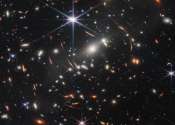Pulverized planet dust might lie around double stars
(PhysOrg.com) -- Tight double-star systems might not be the best places for life to spring up, according to a new study using data from NASA's Spitzer Space Telescope. The infrared observatory spotted a surprisingly large ...









